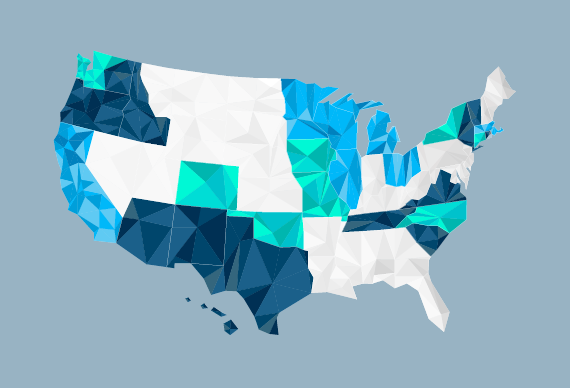
Federal and State Policy
As the largest US healthcare payer, the federal government plays a dominant role in shaping the healthcare marketplace, while states take center stage when it comes to developing novel policy approaches. Our experts track, interpret, and model policies that affect insurance coverage, access, and consumer choice so you can see around the bend.


MedPAC Proposes Changes for 42 Million Medicare Beneficiaries Enrolled in Part D
Cost-sharing changes could increase costs for many beneficiaries.

CORRECTION: Early Analysis Finds 2017 Proposed Exchange Rates Exceed 2016 Increases But Vary Widely By State
Popular low cost options see smaller increases.
Medicare Advantage: 2016 National Snapshot
In 2016, more than 18 of 56 million Medicare beneficiaries receive their benefits from Medicare Advantage (MA) plans. MA plans are private managed care organizations that contract with the federal government to coordinate care for Medicare beneficiaries.

13 Million Adults Could Be Eligible to Purchase Medicare Coverage Under Proposed Clinton Plan
A new Avalere analysis finds that nearly 13 million Americans age 50 or over who are currently uninsured or have individual coverage purchased through the private market-inside and outside the exchange- could be eligible to buy-in to the Medicare program under a plan proposed by Democratic presidential candidate Hillary Clinton.

A Conversation on Prescription Drug Pricing
As the discussion intensifies, one of Avalere's experts provides keen observations on what you need to know about this topic.
2016 Exchange Plans Improve Access to Medicines Used to Treat Complex Diseases
An analysis from Avalere shows that more health insurance plans offered through the Affordable Care Act exchanges are making some drugs used to treat complex diseases—such as HIV, cancer, and MS—more accessible to patients in 2016 than in the previous years. Specifically, plans were less likely to place all drugs in a class on the highest cost-sharing tier.

Medicare Beneficiaries Will Pay More for Biosimilars than for Their Biologic Reference Products in Part D
Two Potential Policy Changes Would Reduce Out-of-Pocket Costs for Consumers

Proposed Medicare Part B Rule Would Reduce Payments to Hospitals and Some Specialists, While Increasing Payments to Primary Care Providers
Rule Would Decrease Medicare Reimbursement for Drugs That Cost More than $480 per Day; Seven of the 10 Most Affected Drugs Treat Cancer

Only 33 Percent of Exchange Enrollees in 2016 Kept Their Same Plan from 2015
One third of those who enrolled in a health insurance plan on Healthcare.gov this year picked the same plan as last year, according to a new analysis from Avalere. In total, 3.2 million of the 9.6 million exchange shoppers in 2016 kept their previous plan.
Proposed Changes to Part D Would Increase Beneficiary Costs
Avalere Experts Estimate MedPAC Proposal to Change Calculation of Part D Enrollees' True Out-of-Pocket Spending Would Increase Beneficiary Costs by $4.1 Billion Between 2017-2020

Changing the Way Insurers are Paid Could Increase Stability in the Exchange Market and Beyond
New Avalere report identifies opportunities to refine the risk-adjustment model that could improve the way Affordable Care Act plans are paid

Right-to-Try Bills Grow in Popularity yet Success Is Unclear
Almost every state has introduced Right-to-Try bills to try to offer patients another avenue to access investigational drugs outside of the Food and Drug Administration's (FDA) expanded access program. However, it is unclear whether these laws will impact patient access given their questionable legal standing, reduced patient protections due to lack of FDA oversight, and the risks to manufacturers of providing products under Right-to-Try laws.

More than 70 Percent of Medicare Advantage Enrollees in Plans with Four or More Stars
Percentage of Medicare Advantage enrollees in plans with at least four stars continues to grow.

Majority of Drugs Now Subject to Coinsurance in Medicare Part D Plans
Percentage of drugs in Part D plans that require coinsurance increased significantly since 2014. Medicare Advantage plans require coinsurance far less often than Part D plans.

Veterans Administration and California Medicaid Drug Lists Cover Less than 60 Percent of Drugs Available to California Public Employees
The CalPERS Basic Plan Drug List, which is the formulary for all California public employees, includes 222 brand drugs and 287 generic drugs. In contrast, drug coverage in the Veterans Administration (VA) and Medi-Cal (California's Medicaid program) is far more limited than the CalPERS drug list.

Avalere’s Take: President Obama’s FY2017 Healthcare Budget
President Obama released his budget for the 2017 fiscal year today. Avalere offers the following observations on the healthcare proposals:

Exchange Enrollment Is on Track to Meet Administration’s Goal
Today, the Department of Health and Human Services (HHS) announced that 9.6 million individuals selected a health insurance plan on HealthCare.gov during the recent open enrollment season. Avalere estimates that 2016 year-end enrollment will slightly exceed the Obama administration's goal of enrolling 10 million people.
Spotlight On: Patient Access to Oncology Care in Exchange Plans
In an article published in The American Journal of Managed Care, Avalere's Caroline Pearson and Deirdre Parsons examine provider networks and benefit design for oncology care in health insurance exchanges.

Prescription-Only Pseudoephedrine-Containing Products Contribute to Growing Primary Care Physician Shortage
According to a new analysis by Avalere, a prescription requirement for pseudoephedrine-containing products also fuels the growing shortage of primary care physicians, thereby increasing the cost, time, and difficultly of obtaining the treatment for legitimate users.

Nearly 60 Percent of New Medicare Advantage Plans Are Sponsored by Healthcare Providers
A new analysis from Avalere Health finds that hospitals and health systems are increasingly taking risk for the cost of Medicare patients and the quality of the care they receive.





